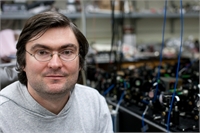Abstract: What is time? Timekeeping so far has been based on the motion of systems of particles, like the solar system, oscillating crystals, or atoms. Quantum mechanics describes a single particle as a wave oscillating at the Compton frequency mc^2/h, where m is the particle's mass, c is the velocity of light, and h the Planck constant. When the particle travels, this frequency is modified by relativistic effects just like the frequency of any standard oscillator or clock. While this picture is equivalent to conventional quantum mechanics (the Schrodinger and Dirac equation), it offers a new, intuitive way of thinking: In theory, time can be measured using only one particle as a reference.
We have used matter waves to test the theory of General Relativity to a precision of 7 parts per billion [1] and to build a matter-wave clock, that measures time (like the duration of this talk) using the Compton frequency as a reference [2]. Time measurement can indeed be based on just one particle. Used the other way around, the Compton clock offers a new way of defining the unit of mass, replacing the last unit that is still defined by an artifact with a definition based on the fundamental constants c and h.
We hope to perform experiments with even more exotic matter waves using antiparticles, the elusive non-identical twins of ordinary particles. This would provide a new way of, for example, measuring the gravitational influence on antimatter [3].
But is a particle really needed to measure time? Maybe clocks can even be made of an even stranger creature: the quantum vacuum. Ephemeral non-particles can appear out of the vacuum without even conserving energy. A virtual electron clock would show that the sheer possibility of an electron is enough to measure time.
References:
[1] A precision measurement of the gravitational redshift by the interference of matter waves. Holger Müller, Achim Peters, and Steve Chu. Nature 463, 926 (2010).
[2] A clock directly linking time to a particle’s mass. Shau-Yu Lan, Pei-Chen Kuan, Brian Estey, Damon English, Justin Brown, Michael Hohensee, and Holger Müller, Science, 339, 554 (2013).
[3] Antimatter interferometry for gravity measurements. Holger Müller, Paul Hamilton, Andrey Zhmoginov, Francis Robicheaux, Joel Fajans, and Jonathan Wurtele, arxiv:1308.1079.
Biography: Holger Müller submitted his first patent when he was 14. Later, he did his undergraduate thesis with Jürgen Mlynek at the University of Konstanz, Germany. He graduated from Humboldt-University, Berlin, with Achim Peters as advisor. Müller received a fellowship of the Alexander von Humboldt foundation and joined the group of Steven Chu in Stanford as a postdoc. In July 2008, he joined the physics faculty at U.C. Berkeley.

